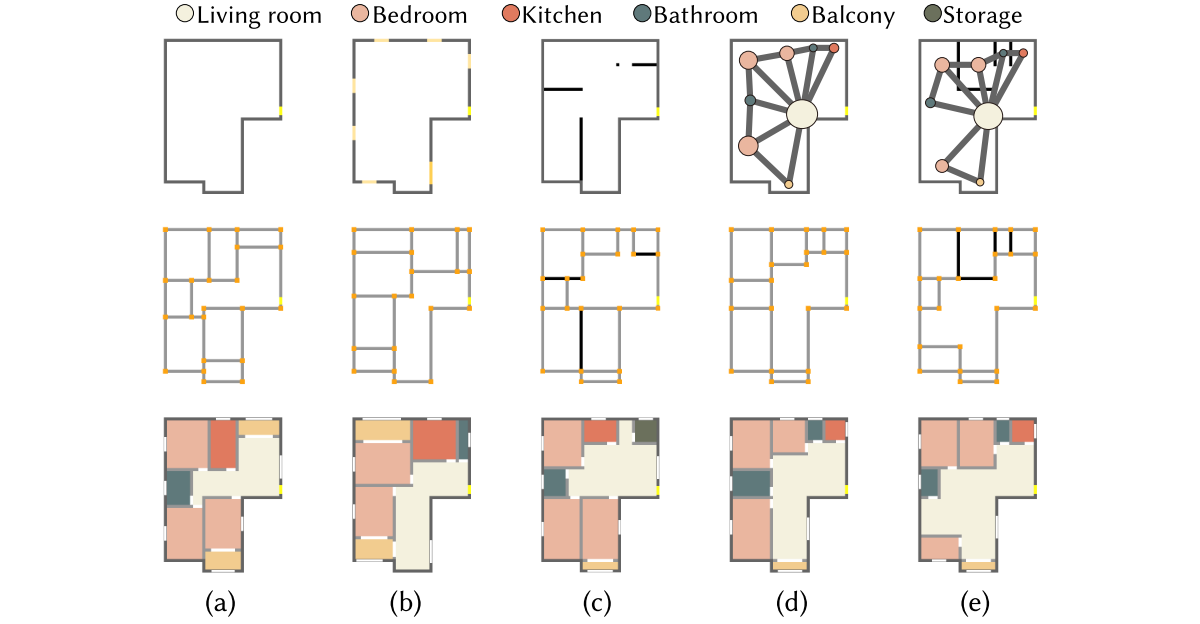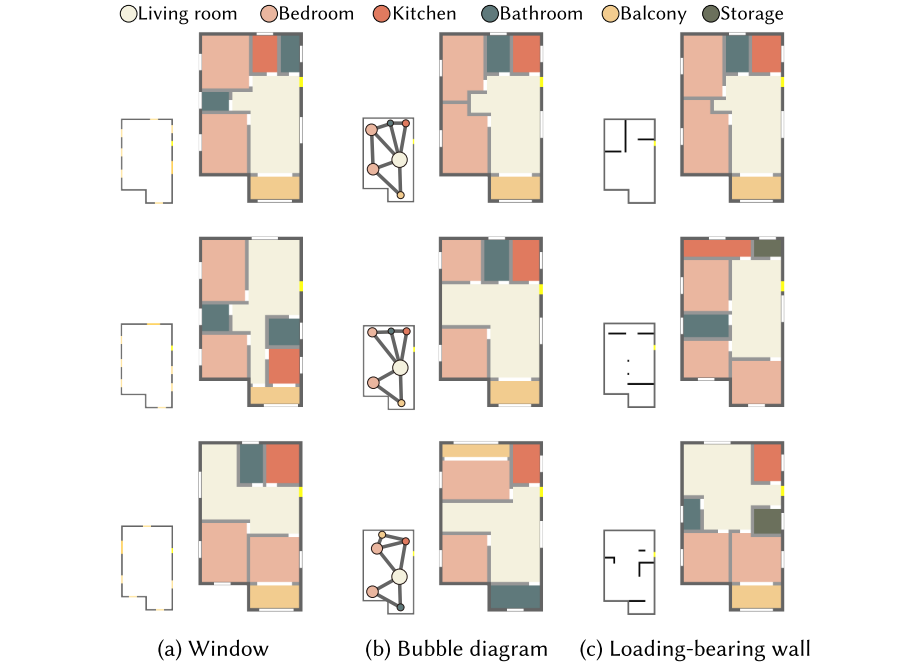WallPlan: Synthesizing Floorplans by Learning to Generate Wall Graphs
Jiahui Sun1 Wenming Wu1 Ligang Liu2 Wenjie Min1 Gaofeng Zhang1 Liping Zheng1
ACM Transactions on Graphics (Proc. of SIGGRAPH 2022)

Figure 1. We propose to synthesize floorplans by learning to generate wall graphs using deep neural networks. Top row: floorplans generated by our method with various input boundaries. Bottom row: our method generates the graph with wall junctions (in orange) as nodes and wall segments (in blue) as edges in an iterative manner for the example outlined in the dotted box. Room labels are represented in different colors, as shown in the upper-right.
Abstract
Floorplan generation has drawn widespread interest in the community. Recent learning-based methods for generating realistic floorplans have made significant progress while a complex heuristic post-processing is still necessary to obtain desired results. In this paper, we propose a novel wall-oriented method, called WallPlan, for automatically and efficiently generating plausible floorplans from various design constraints.We pioneer the representation of the floorplan as a wall graph with room labels and consider the floorplan generation as a graph generation. Given the boundary as input, we first initialize the boundary with windows predicted by WinNet. Then a graph generation network GraphNet and semantics prediction network LabelNet are coupled to generate the wall graph progressively by imitating graph traversal. WallPlan can be applied for practical architectural designs, especially the wall-based constraints. We conduct ablation experiments, qualitative evaluations, quantitative comparisons, and perceptual studies to evaluate our method’s feasibility, efficacy, and versatility. Intensive experiments demonstrate our method requires no post-processing, producing higher quality floorplans than state-of-the-art techniques.
Overview

Figure 2. Overview of WallPlan. (a) The building boundary, as well as the front door (in bright yellow), is given as input ofWallPlan. (b) The boundary is initialized with windows (in dark yellow) predicted by WinNet. (c) WallPlan generates both the wall graph and floorplan semantics by a coupled structure of GraphNet and LabelNet from the input boundary and windows. (d) The generated wall graph and floorplan semantics are used to construct a wall graph with room labels as output ofWallPlan. The vectorized floorplan can be directly obtained from the wall graph. Note that the drawing of windows and interior doors which are generated using a heuristic method is only used for visualization, also adopted by other figures in this paper.

Figure 3. Architecture of WallPlan. Given the boundary with windows as input, WallPlan generates both the wall graph and floorplan semantics progressively by imitating graph traversal, then a wall graph with room labels can be obtained. When no nodes can be generated, the generative process is terminated.
Results

Figure 4. Constrained floorplan generation. Top row: various design constraints applied to the same boundary. Middle row: output wall graphs. Bottom row: floorplan visualization of wall graphs. (a) Only the input boundary. (b) Window constraint. (c) Load-bearing wall constraint (black dots and line segments). (d) Bubble diagram constraint (represented as the layout graph). (e) Hybrid-constraint. The overall structure of the floorplan changes significantly with different constraints.

Figure 5. Comparison to the state-of-the-arts with the only boundary constraint. Each row shows the results of different methods applied to the same boundary. (a) The ground truth floorplans, and the floorplans generated by (b) RPLAN, (c) Graph2Plan and (d) our method.

Figure 6. Generating multiple floorplans from the same boundary with different constraints. Each column shows the different settings of the specific design constraint applied to the same boundary. (a) Window constraints. (b) Bubble diagram constraints. (c) Loading-bearing wall constraints.
Acknowledgement
We would like to thank perceptual study participants for evaluating our system and the anonymous reviewers for their constructive suggestions and comments. This work is supported by the National Natural Science Foundation ofChina (62102126, 62025207, 61972128) and the Fundamental Research Funds for the Central Universities of China (PA2021KCPY0050).
BibTex
@article{Fan:2018:IPLayout,
title = { WallPlan: Synthesizing Floorplans by Learning to Generate Wall Graphs},
author = { Jiahui Sun and Wenming Wu and Ligang Liu and Wenjie Min, Gaofeng Zhang and Liping Zheng},
journal = { ACM Transactions on Graphics},
year = { 2022},
}
Materials
Paper: final.pdf
Video: video
